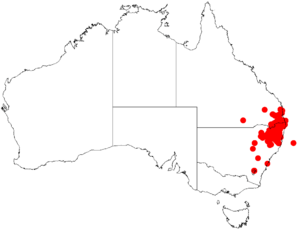Acacia viscidula facts for kids
Quick facts for kids Acacia viscidula |
|
|---|---|
| Scientific classification | |
| Genus: |
Acacia
|
| Species: |
viscidula
|
 |
|
| Occurrence data from AVH | |
Acacia viscidula, also known as sticky wattle, is a special kind of shrub that belongs to the Acacia family. It's found only in certain parts of eastern Australia. This plant gets its name "sticky wattle" because it can feel a bit sticky to the touch!
Contents
What Does Sticky Wattle Look Like?
This shrub usually grows to be about 1 to 4 meters (3 to 13 feet) tall, but sometimes it can reach 5 to 6 meters (16 to 20 feet). It can also spread out to about 4 meters (13 feet) wide. Its bark is smooth and grey or grey-brown. The branches are often angled, a bit sticky, and can have small hairs.
Like most Acacia plants, the sticky wattle doesn't have true leaves. Instead, it has what are called phyllodes. These are like flattened leaf stems that do the job of leaves. The phyllodes of the sticky wattle are thin and can be hairy or smooth. They are shaped like long, narrow lines, usually 4 to 8 centimeters (1.6 to 3.1 inches) long and 1 to 3 millimeters (0.04 to 0.12 inches) wide. They have a few distinct, sticky veins.
Flowers and Seed Pods
Sticky wattle blooms between August and October. It produces simple flower clusters that grow alone or in pairs where the leaves meet the stem (called the axil). These flower heads are round, about 4 to 7 millimeters (0.16 to 0.28 inches) across, and have 15 to 35 light to bright yellow flowers.
After the flowers, seed pods form. These pods are usually straight but can be slightly curved. They are raised over each seed and sometimes a little pinched between them. The pods are 2 to 7 centimeters (0.8 to 2.8 inches) long and 2 to 3 millimeters (0.08 to 0.12 inches) wide. Inside, the seeds are arranged lengthwise.
How Sticky Wattle Got Its Name
The sticky wattle was first officially described by a botanist named George Bentham in 1842. It was part of a larger work about Mimoseae plants. For a while, in 1987, it was reclassified as Racosperma viscidulum by Leslie Pedley, but then in 2006, it was moved back to the Acacia group.
The second part of its scientific name, viscidula, comes from a Latin word that means "sticky." This is a perfect description for the plant, as it often feels a bit sticky! It looks similar to Acacia lanigera and Acacia dawsonii, which are found in different areas.
Where Does Sticky Wattle Grow?
Sticky wattle is found in the Darling Downs area of southeastern Queensland and in eastern parts of New South Wales in Australia.
In Queensland, you can find it as far west as Injune. In New South Wales, it grows as far west as Coonabarabran. It prefers to grow in higher areas with granite-based soils. You'll often see it as part of low woodland communities, growing alongside different types of Eucalyptus trees and other Acacia plants.
In New South Wales, it's mostly found in the Tablelands Region. Its range stretches from around Tamworth in the south, out to Mount Kaputar National Park in the west, and to around Tenterfield in the west. Here, it usually grows in dry sclerophyll forests or among the heath in rocky cracks of granite outcrops.
Growing Sticky Wattle
You can buy sticky wattle as young plants (seedlings) or as seeds. If you're planting seeds, they need to be treated with boiling water first to help them sprout. It might also be possible to grow new plants from cuttings.
This plant is great for creating a screen or an informal hedge in a garden. Because it can grow quite densely, it makes a good nesting spot for small native birds. It grows quickly and can handle full sun or partial shade. It can also tolerate a light frost and is good at surviving dry periods (drought tolerant) once it's established. It prefers soil that drains well.

